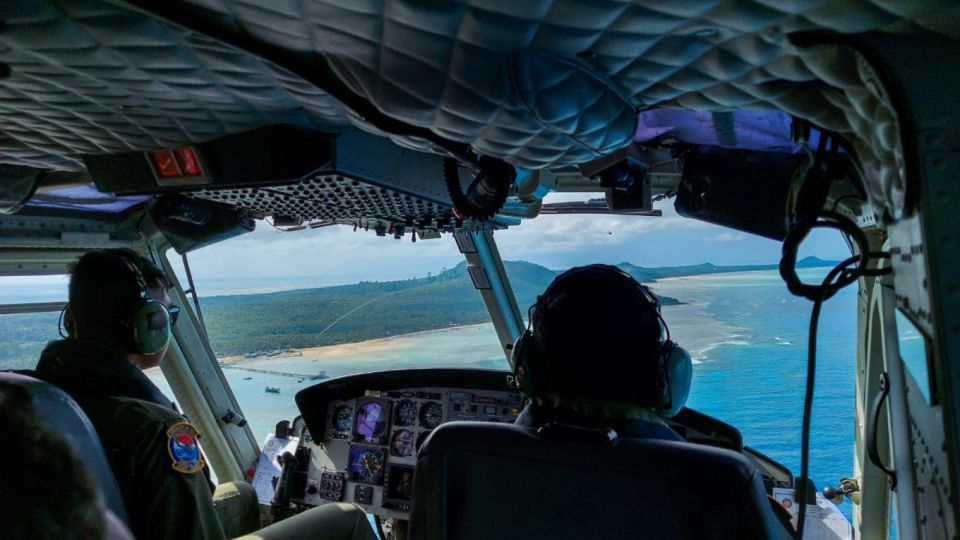November 29, 2021
As a fisherman from Laut Island, the northernmost inhabitable place in Natuna regency, Riau Islands province, 46-year-old Asmareno says he often has run-ins with foreign fishing vessels, an experience he describes as “very disturbing”.
“They don’t bother us, but they do tell us to leave, which we do because we are afraid,” he told The Jakarta Post on Wednesday, as members of the National Border Management Agency (BNPP) made a working visit to the island. Located about six hours from Natuna’s capital of Ranai, Laut Island is home to some 2,200 people, most of whom are fishermen.
It lies at the southern tip of the South China Sea, a highly strategic and resource-rich body of water upon which China, Brunei, Malaysia, the Philippines, Taiwan and Vietnam have sometimes overlapping claims.
The island is adjacent to one of Indonesia’s most remote exclusive economic zone (EEZ) baseline markers, located in the North Natuna Sea, where curbing illegal, unreported and unregulated fishing remains a big challenge for the local authorities, as they regularly face encroachments from Malaysia, Vietnam and China. But nowadays, Asmareno is also concerned about competing with fishermen from the northern coast of Java, who have started to overcrowd local fishing spots.
At a public discussion held on the island, Asmareno asked Home Minister Tito Karnavian and Coordinating Political, Legal and Security Affairs Minister Mahfud MD – both members of the BNPP – to assign the out-of-town fishermen to waters at least 30 miles away from Laut Island so they wouldn’t have to compete with each other for their catch.
Stiff competition
Locals have decried what they say is the unfair advantage given to out-of-town fishermen sponsored by the government to protect the border from foreign encroachment. The move has had unintended consequences for Natuna’s fishing community as locals are made to share their fishing grounds with better-equipped fishermen from Java, Sumatra and elsewhere.
Another Laut Island resident, Tabrani, said it was unfortunate that locals now had to compete with the new arrivals. “Some of us are now forced to scavenge for octopus near the coast, because fishing in the open sea has become very difficult with the vessels from Pekalongan [Central Java] coming in equipped with their 1,000-watt lamps and trawling nets that allow them to catch tons of fish,” he told the ministers. “We can’t do anything about it.”
He also said it was “unethical” to allow trawling nets to be used just 12 nautical miles from the coast and that the state should have consulted with the local population before it put the policy in place. “When we clash with foreign fishermen, we can ask the Indonesian Military [TNI] or the fisheries authorities to help us. But nowadays, it’s mostly just competition among Indonesian citizens with unequal capacities,” Tabrani said.
Problematic policy
The residents have urged the government to provide a local cold chain facility and a modern fish market so that their catch can be sold at higher prices. Asmareno said he sold most of his catch locally for low prices. Because he used traditional fishing rods, he added, the number of fish he caught could vary widely.
On a good day, he could get 300 to 500 kilograms of fish, but on others, he might catch less than 100 kg. The public dialogue on Laut Island allowed local fishermen to voice their concerns, but the visiting officials insisted that the policy of bringing fishermen in from other regions had been put on hold.
The idea to encourage vessels from Java’s northern coast to fish in the North Natuna Sea was proposed by Mahfud after a series of skirmishes with Chinese authorities over illegal fishing in 2020. During an earlier press briefing on Tuesday, the minister said the initiative had been intended to increase the Indonesian presence in the waters and was not intended to rob local fishermen of their income.
“Indeed, in the implementation, we encountered some technical problems. Boats were too small to stay in such a vulnerable place, and we had communication issues with the local fishermen, so in the end, the policy was postponed,” Mahfud told reporters during the trip.
Affording protections
According to the Washington-based Center for Strategic and International Studies (CSIS), which is funded by the United States Department of State, China has systematically expanded its maritime militia in the South China Sea over the past decade, as part of its strategy to assert more control over the contested waters.
A report by the center’s Asia Maritime Transparency Initiative (AMTI) claimed that China’s maritime militia consisted of as many as 300 vessels, composed of purpose-built armed militia vessels and commercial fishing boats. The strategy has been described by experts as a prime example of China’s “grey zone” tactics.
When asked about the possibility of trying similar tactics, Tito said the government’s approach was more to empower local fishermen and provide security through the Navy, the Maritime Security Agency (Bakamla) and other relevant law enforcement agencies.
“Our laws prohibit the use of weapons by institutions that are not authorized for the use and possession of weapons, but [local fishermen] will be under the protection of – and supported by – our defense and security forces,” he said.


